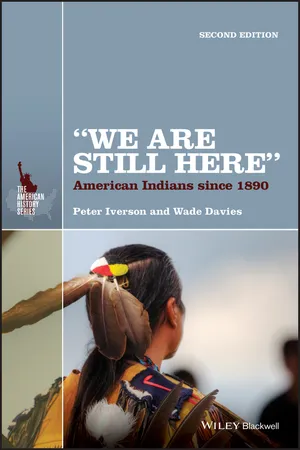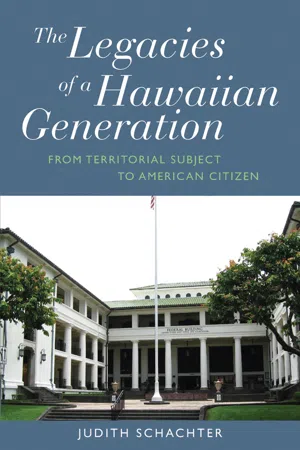History
Native Americans in WW2
During World War II, many Native Americans served in the military, contributing their unique skills as code talkers, scouts, and soldiers. Despite facing discrimination and challenges, their contributions were significant and helped to achieve victory. Additionally, the war experience led to increased awareness of Native American issues and paved the way for advancements in civil rights for indigenous peoples.
Written by Perlego with AI-assistance
Related key terms
1 of 5
4 Key excerpts on "Native Americans in WW2"
- eBook - ePub
"We Are Still Here"
American Indians Since 1890
- Peter Iverson, Wade Davies(Authors)
- 2014(Publication Date)
- Wiley-Blackwell(Publisher)
He did not know the satisfaction or hear the accolades Native men and women received from their many contributions to the national effort. But he would be remembered, and his particular story would be told. There are many American Indian narratives from the war and, of course, no single one is representative of that collective experience. Many of those stories involved struggle and death. Some emphasized tragedy, some survival, others triumph. Now, many decades after the war's end, they continue to be repeated, and they still hold lessons about the significance of the war years. They suggest that in some ways the era yielded a kind of turning point in the modern Indian experience. In Speaking of Indians, published in 1944, Ella Deloria (Yankton Sioux) observed: “The war has indeed wrought an overnight change in the outlook, horizon, and even the habits of the Indian people—a change that might not have come for many years yet.” However, this period also often accentuated or emphasized trends already under way in individual lives and in the communities that Native peoples called home. American Indians had not been completely isolated before 1941. Many had left reservation environments to attend school; others had gone to the city to work. Federal programs had left their mark on tribal government, land use, education, and health care. Nonetheless, the war allowed countless thousands of Indians to perceive and experience the larger society of America. These perceptions and experiences, in turn, affected individual and group decisions about life in the postwar era. World War II and Its Consequences Although many Native Americans rushed to volunteer for the war effort, others resisted the demands of the Selective Service Act of 1940. Now that all Indians were citizens, they all faced the draft. Even the Iroquois in New York who supported the United States' cause, for example, questioned the authority of the federal government to force men to fight - eBook - ePub
First Americans: A History of Native Peoples, Combined Volume
A History of Native Peoples, PowerPoints
- Kenneth Townsend(Author)
- 2018(Publication Date)
- Routledge(Publisher)
The war also brought significant change to Native Americans on the home front. At least 40,000 Indians left their reservations and secured training and employment in defense factories situated in urban communities. They learned new skills and trades that promised postwar employment in cities and towns, earned record high wages during the war, and generally found full inclusion in the larger dominant society. Reservations marshaled their resources for military use, and tribal communities contributed directly in all national security efforts and programs. But the war also instilled a new identity among many Indians. Racial prejudice, evidenced in Virginia and elsewhere, along with the federal government’s negation of historic treaties that derailed tribal sovereignty combined to forge among many Indians a determination to carve their own place in society, a place separate from both whites and African Americans. This new determination was in direct conflict with the emerging consensus in the federal government that it was time to move toward final termination of all services to Native Americans and full assimilation of Indians with white society, a consensus that was the direct consequence of the successful wartime inclusion of Indians in the military and civilian sectors.Review Questions
- In what ways did Native Americans assert their separate identity as Indians during World War II? How did the federal government and non-Indians generally demonstrate the full and equal inclusion of Native Americans in the war effort?
- How did the Selective Service Act and Nationality Act of 1940 affect tribal sovereignty and the Indians’ heretofore special relationship with the U.S. government?
- Why was the Native American response to the military draft and Indian enlistment into the armed forces so overwhelmingly positive? What was the basis for some Indians’ resistance to compulsory military service?
- In what ways did American Indians on the home front demonstrate their support for the nation’s war effort? How did these activities also aid Indians themselves?
- “Native American participation in the armed forces, in domestic wartime programs, and in debates concerning their identity and status within the United States together suggested an emerging spirit of activism by Indians, for Indians.” Explain.
Recommended Readings
Golodoff, Nick. Attu Boy: A Young Alaskan’s World War II Memoir - eBook - ePub
The Legacies of a Hawaiian Generation
From Territorial Subject to American Citizen
- Judith Schachter(Author)
- 2013(Publication Date)
- Berghahn Books(Publisher)
But the outcome differed, as did the characterization of the victims of “manifest destiny.” In the eyes of governing authorities, the American Indian remained a threat, dangerous, and resistant to the civilizing mission well into the twentieth century. The Native Hawaiian, on the other hand, received the not-less-demeaning characterization of docile and obedient. When the First World War broke out, members of Congress debated long and hard about letting the “savage” American Indian fight next to civilized white soldiers. Meanwhile, Native Hawaiians were encouraged to enlist, and did so. 71 Only the Army was at issue—the Navy, Marines, and Air Force remained exclusively white until the Second World War. In the end, Congress was persuaded of the value the American Indian could bring to a nation at war. Placed in white units, the American Indians were given tasks that fit their perceived abilities, serving primarily as scouts and code-breakers. 72 They were rewarded with American citizenship in 1924. When Franklin Roosevelt declared war in 1941, the problem of American Indian military status had been resolved by the earlier decision. Questions about Native Hawaiian patriotism and loyalty had been moot for decades. Enlistees and draftees from both groups of indigenous people were assigned to white units. “Colored” units were reserved for African-Americans who, accepted into service, were not accepted into Caucasian units. During training, John did not encounter a black soldier in any of the drills and practices. However, he may have marched next to a Navajo, a Mexican-American, an Italian American, or a Chinese-American. War with Japan distinguished the Japanese from the Chinese citizen; in one case, the home nation was enemy and in the other ally of the United States. 73 The blanket racial category of Asian that had determined immigration and naturalization policies for over a century broke against the nationalist assumptions of wartime - eBook - ePub
The Routledge Handbook of American Military and Diplomatic History
1865 to the Present
- Christos Frentzos, Antonio S. Thompson, Antonio Thompson(Authors)
- 2013(Publication Date)
- Routledge(Publisher)
22Indian veterans returned home with pride, with self-confidence, and with a greater sense of national belonging and acceptance. Wartime experiences had broadened their outlook on life, and many were able to translate their training and newly acquired skills into better jobs and a more secure future at home. Others struggled to readjust to reservation life—haunted perhaps by the recent atrocities they had witnessed on the Western Front. Just a few decades earlier, many Americans had accepted the contention that Indians were a “Vanishing Race” and that their “inherent” backwardness and unwillingness to accept assimilation would doom them to inevitable extinction. Service during the war, however, offered convincing proof that Native Americans were vibrant and persevering peoples who had much to offer the majority culture. Viewed in this light, the war years may have helped hasten the evolution of popular misconceptions from the “Vanishing Race” scenario back to other stereotypes that glorified the martial and virile attributes of Indian men—stereotypes that had important consequences for Indian soldiers and the types of duties they performed in World War I and in future wars.23Native Americans also made substantial contributions on the home front. Reservation families were active in Red Cross work, and several thousand Indian families bought Liberty bonds and war stamps. Indian women knitted socks, mufflers, sweaters, and hospital garments for American soldiers, while Indian farmers stepped up production of agricultural products. For many tribes, the war years brought about a renewal of customs and traditions they had not practiced in a generation. Indian veterans of World War I, for example, returned home to purification rituals, victory dances, feasts, and giveaways. A fortunate few even gained admittance to previously inaccessible warrior societies that required young men to demonstrate bravery on the battlefield. Other veterans returned home bearing deep physical and emotional scars that undermined their reintegration into society. Military service during World War I, therefore, can be seen as a catalyst for cultural renewal among Indian peoples, an irony considering the goals of policymakers who had hoped that military service would encourage assimilation.24
Index pages curate the most relevant extracts from our library of academic textbooks. They’ve been created using an in-house natural language model (NLM), each adding context and meaning to key research topics.



